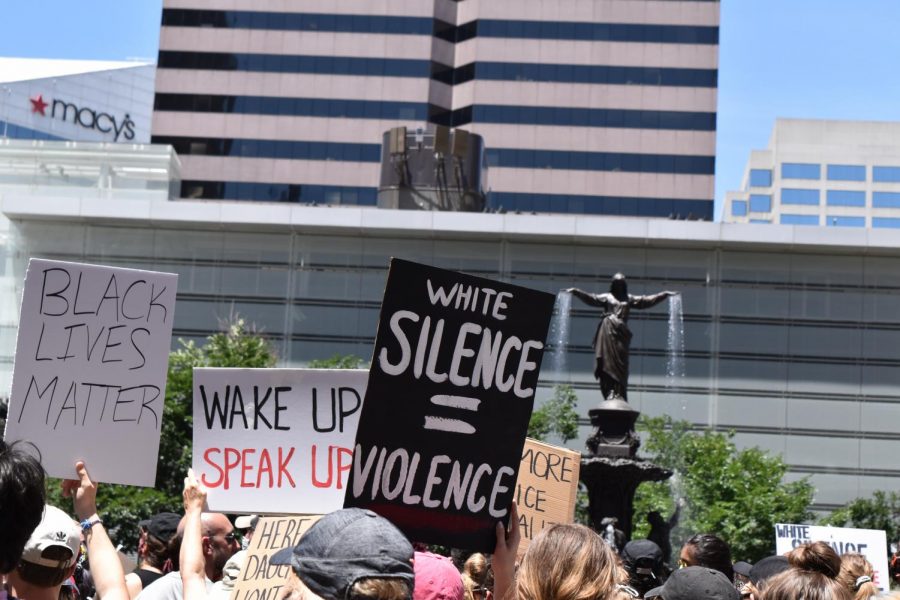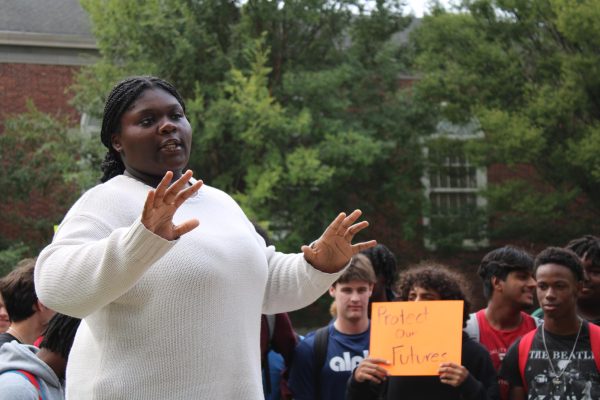CPS’ new Anti-Racism Policy, explained
A protest was held in Fountain Square on June 6, in response to the murder of George Floyd. Racial unrest this summer spurred Cincinnati Public Schools to begin work on an anti-racism policy.
On Dec. 16, 2020, the Board of Cincinnati Public Schools voted unanimously to adopt an Anti Racism policy that had been in the works since June.
The CPS Policy Committee and General Counsel’s office began researching the policy in the summer of 2020 in light of racial unrest in America. They worked with an Anti Racism Working Group of students, parents, staff and community members. The group included representatives from the African American Chamber of Commerce, All In Cincinnati, Children’s Hospital, Cincinnati Preschool Promise, Closing the Health Gap, The Urban League, the YMCA and YWCA.
The policy builds on CPS’ Equity policy, adopted in 2016, but is one of the first explicitly “anti-racist” school policies of its kind.
CPS defines anti-racism as “the practice of identifying, challenging, and changing the values, structures, and behaviors that perpetuate systemic racism.”
“When you’re talking about anti-racism, it’s about being proactive, as opposed to reactive,” Assistant General Counsel Stephanie Scott said, “I believe in even drafting the policy, that’s the district kind of demonstrating that it wants to take the proactive approach.”
The initial draft was released for public feedback on July 10. The adopted final policy can be found on the CPS website.
After defining its key terms and purpose, the policy looks into the six directives of communication, leadership and administration, curriculum and instruction, training and professional development, hiring practices and policy enforcement.
Purpose
In the purpose statement, the district acknowledges the multifaceted problems of racism in CPS schools and identifies its goal to find and eliminate racist practices.
“In this District, there are significant differences between racial groups in student academic performance, co and extracurricular programs, family engagement and partnership support,” it states.
The policy specifically names inequalities in terms of discipline rates, economic advantages, Disabilities Identification, Advanced Placement, College Credit Plus, career technical programs, gifted/enrichment programs, counseling, athletics, arts and electives.
The district also states that it is committed to annual self-evaluation and continued training.
Communication
Key takeaways:
- Each Local School Decision Making Committee (LSDMC) will have a new sub-committee “regarding anti-racism efforts and accountability.”
- The Anti Racism policy will be in student handbooks in the upcoming year.
- The district will create benchmarks to measure progress in its anti-racism goals.
- The district will utilize surveys of staff, students, and families to measure progress in its anti-racism goals.
According to Scott, the benchmarks will likely include both qualitative and quantitative data and will be established by department heads alongside a new Diversity, Equity and Inclusion Manager.
“We want to make it clear so that people know that this is part of our culture and who we are and we embrace this emblem,” Scott said.
Leadership and Administration
Key takeaways:
- The district will develop an annual Racial Disparities Assessment and Audit.
- The district will direct school leaders to “create equal access and equitable support for students interested in or qualified for advanced coursework regardless of their home school assignment or choice.”
- The district will hire a Diversity, Equity, and Inclusion Manager.
- Supervisors will be trained and authorized to address racist and race-based misconduct.
CPS has documented racial disparities related to advanced coursework. In 2019, 55 percent of white CPS students in grades 10-12 were enrolled in AP courses. Only 20 percent of Black students took AP courses.
In 2020, the Chatterbox reported that students and teachers see racial inequalities in the makeup of advanced classes at WHHS as well.
Addressing these disparities will be one of many directives addressed by the new Diversity, Equity, and Inclusion Manager (DEIM), to be named by the start of the 2021-22 academic year. The DEIM will oversee implementation of the anti racism policy as well as other forms of inclusion throughout the district.
Curriculum and Instruction
Key takeaways:
- A redesigned curriculum will be anti-racist and represent diverse perspectives.
- The Board will support activities that “foster respect for cultural and racial diversity” beyond designated days/months such as Black History Month in February.
- All curriculum materials will be examined for racial bias, allowing for input from students.
Implementation of an anti-racist curriculum will be lead by CPS’ Curriculum Department. The department gave an initial presentation to the board on Oct. 19.
“Over the past several months several states and districts throughout the nation have reckoned with social studies curricula that are biased, do not accurately represent diverse cultures and do not equip students to challenge racism,” Rachel McMillan, a teacher at Aiken High School, said at the meeting.
As of October, the Social Studies Department started an audit of the k-12 curriculum, one goal being to create a Black history curriculum told from the perspective of Black voices.
A review of the English Language Arts curriculum will also include opportunities to teach about social justice.
According to McMillan, biased and problematic curricula have historically been made “top-down,” leaving out students, families and teachers. The new curriculum will be made “ground up,” consulting community members in its creation.
Training and Professional Development
Key takeaways:
- All staff will complete a program about anti-racism in the first year of being hired and will be retrained annually. All current staff will be trained in the policy.
Education Week reports that lack of training in diversity and racism is a problem across the education field. According to a 2020 survey, 82 percent of educators had not received “anti racist or abolitionist” professional development in their preparation programs.
Hiring Practices
Key takeaways:
- The district “shall include in its hiring practices and systems the opportunity to share information with applicants regarding the District’s anti-racism stance.”
- The district will report and analyze hiring data aggregated by race to identify any biases.
An American Educational Research Association study in 2020 found that teachers are equally likely as non-teachers to have implicit racial biases. These biases can be addressed through training, but may also play a role in job candidate screening.
Last year, Teach For America highlighted schools that have incorporated their anti-racist goals into hiring protocols. At the High School of Commerce in Massachusetts, candidates must demonstrate understanding of biases and commitment to anti-racism to move on in the hiring process.
The initial draft of CPS’ Anti-Racism policy stated that “All candidates being considered for hire within the district will be asked appropriate questions to gauge their understanding of anti-racist practices. Additionally, candidates will be screened for implicit and explicit biases.”
Scott said that this specific language was removed from the final policy in order to give the human resources department the ability to meet anti-racist goals in the way it determines is best. This does not necessarily mean that these questions and screening will not be utilized in the hiring process.
“The goal of the policy was to level-set, and to have a standard in place, and then of course we will rely on the experts within our district in their respective departments and certain areas to help us create procedures that align with the policy,” Scott said.
The policy states that hiring protocols will be reassessed and altered if needed.
Policy Enforcement
Key takeaways:
- All schools will report data on all disciplinary actions. This data will be reviewed to better understand disparities.
- If someone has committed a racist act, schools will create an opportunity to “learn about the impact of their actions on others through such practices as restorative practices, mediation, role play or other explicit policies or training resources.”
- There will be various ways to report racism, including anonymous reports.
Disparities in discipline rates for students of color is one of the most prominent issues in the movement for anti-racist schools. However, discipline is not addressed in detail in the policy.
In April, the Ohio American Civil Liberties Union (ACLU) released a case study of discipline in CPS, collaborating with the Young Activists Coalition and WHHS students.
The study states that Black students in CPS are five times more likely than white students to receive exclusionary discipline. Exclusionary discipline measures, like suspension or arrest, occur when students are removed from the classroom.
The Memorandum of Understanding (MOU) between CPS and the Cincinnati Police Department states that, “non-criminal violations of student conduct are the responsibility of school administrators.” However, the ACLU report suggests that these non-criminal violations are often handled by school resource officers rather than school staff. The report advocates for the termination of the MOU.
“School Resource Officers are called to resolve at least 4850 conflicts annually,” the report states, “The vast majority are so minor that they don’t result in any discipline. School administrators can – and should – handle them instead.”
In a statement responding to the report, CPS said that it is addressing these problems and working with groups such as Speak Up and Speak Out. According to the statement, the district’s student-led forum on racial injustice wants to create “a stronger relationship between students and the Cincinnati Police Department.”
Looking forward
Although CPS is not officially taking feedback on the policy, students, parents and staff can contact the General Counsel’s office or the Policy Committee, chaired by board member Mike Moroski.
Students and staff can report racial misconduct through the anonymous harassment hotline (513-363-0111), which goes through the General Counsel’s office. Scott also encouraged students or staff to bring up non-harassment issues such as curriculum concerns with school staff they feel comfortable with.
As CPS begins implementing the policy, Scott foresees some difficulties but is hopeful.
“You can always have these goals and aspirations as an organization of where you want to be, but an organization is made up of the sum of its individual people,” she said, “But it seems like as a whole, this is something that CPS is embracing, it seems like as a whole society and our country is wanting to embrace it.”
Your donation will support the student journalists of Walnut Hills High School. Your contribution will allow us to purchase equipment, cover our annual website hosting, printing costs and offset competition and conferences fees for students.














